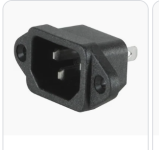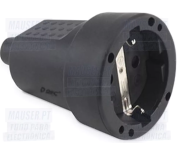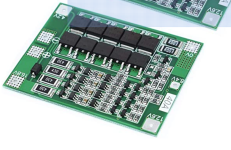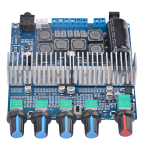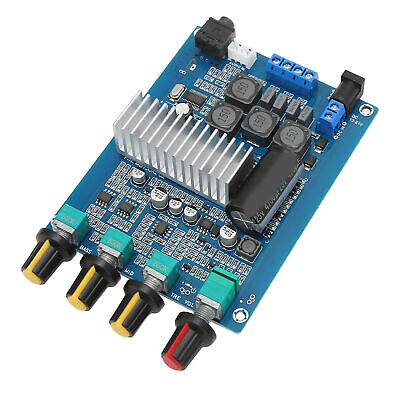You shouldn't use just an AC adapter to charge the batteries unless it is a CC-CV type (like a lithium charger or an LED PSU), so that it limits current to the batteries below the max charge rate they can accept by lowering it's voltage automatically. This one on aliexpress
says it is one that can do up to 2A charge rate. Your linked cell doesn't show charge rate specs on the page, but this page
says it's 0.6C, which for a 3.4Ah cell would be 2A, so it should work. There are probably lots of this type of charger out there, so you can look for the best quality one / most reliable one that fits your usage and needs and budget. Since a charger failure can cause a battery fire, it's good to have one you can count on.

I would not use a DC-DC converter between battery and amp. First it will introduce noise to some degree into the amp (the battery will not). It might not be much noise, but it can be pretty annoying with cheap poorly filtered DC-DCs (same thing with wall-wart AC adapters). Next it must be sized to handle the *worst case* power surge the amp will ever draw under any circumstances, or it could be damaged by the amp (this part isn't likely to be a problem for low power, but high power could be). Third it will waste power you could have used to make sound, and capacity you could have used to play longer.
You can instead use the space it would have taken up to put more cells in the battery, and get either more voltage or more capacity/more current-capability for less voltage sag under load (more watts to your speaker).
If 24v is the amp's actual max voltage, the most cells you can series is 5s Li-Ion for a max full charge of 4.2v x 5 = 21v. Average voltage will then be about 18v.
A DC-DC will only output what it's rated to, regardless of the input voltage. If you exceed the input voltage range in it's specs, it will just damage the DC-DC.
The speaker linked is 5.3ohm, so it should work with the amp linked (specs below). Not much bass response; what instrument will you be playing? Heavy, would guess your cabinet/amp is going to be 10lbs+ by the time you've got everything in the box.
Based on the amp info, it doesn't say it supports bridging a single speaker across both channels for more power, so you can only use half the power of the amp; at 12v nominal (4s LiFePO4) that's only 15W @4ohm (it'll be a little higher with the higher voltage of a 4s Li-Ion pack, but a little lower because of the higher speaker impedance; my guess is still around 15W). In it's specs, it also has "reception distance" listed, but I don't know what it means as it doesn't indicate any wireless functions.
A mono output amp, or one that can be bridged, would be better for your purpose. This randomly found example
is up to 100W (I'm sure you'd need a big heatsink to the outside of the cabinet for the amp chip to do that much), and runs off 12-32v, so you can use a higher voltage pack on it (up to 7s) for more Wh too. It is AC input at the terminals, but if you solder the battery input to the +/- terminals of the rectifier (or the big capacitors) it works on DC, too--and you could even wire it with a switch to disconnect the battery and connect the AC input so you can run it with an external AC transformer in places that allow that, saving the battery for later. I'm sure there's others out there that are DC-only; I didn't look.
(aliexpress alone has thousands of different amplifiers; I recently went looking so I can change a crappy amp in a little old computer speaker that's going inside a 5v-only project, and replace a blown amp in a decent speaker bar, and add bluetooth reception to my music studio's speakers, etc).
To get 15W at the 14v or so nominal of 4s of the cells you list, it'll only take about an amp of current on average. The cells can do 8A at 1p, so no problem there. Assuming 3Ah usable capacity, a 4s1p pack would probably last about three hours of busking at that rate. You can also calculate capacity needed with Wh: 3Ah x 14v = 42Wh, at 15W constant usage it'd be just under 3 hours, but you will probably not use that much power constantly so it could last longer.
If you use a 5s1p pack you'd get a few more Wh and a higher power output from the amp, if you use the higher power a lot it will probably not last any longer but more people will hear you.

The OKYSTAR BMS would probably work, but is likely overkill for your amp's current needs. You can probably get away with a 10A or less unit, even a 5A if anyone makes one would probably work.
I think I was going to type some more info but JellyBean the Perfectly Normal Schmoo required bellyrubs so I had to wait till she started a nap to continue.
 Specification:
Specification:
Item Type: Digital Amplifier Board
Material: PCB
Operating Voltage Range: DC12-24V
Reception Distance: > 8m/26.2ft
Version: 4.2
Sound Source Input Sensitivity: 600-800mV
Frequency Range: 20Hz-20KHz
Speaker Impedance: 4-8Ω
Output Power:
Power 12V 8Ω Speakers> 10W x 2, 12V 4Ω> 15W x 2
21V 8Ω> 30W x 2, 21V 4Ω= 50W x 2
24V 8Ω> 35W x 2, 24V 4Ω> 60W x 2
Samsung INR18650-35E 3400mAh - 8A
| EAN / GTIN | 9009316342928 |
|---|
| Weight - g | 49 |
|---|
| Brand | Samsung |
|---|
| Model | INR18650-35E |
|---|
| Size | 18650 |
|---|
| Battery chemistry | Li-ion |
|---|
| Battery | Rechargeable |
|---|
| Voltage | 3.6V |
|---|
| Min. capacity - mAh | 3,350.00 |
|---|
| Typ. capacity - mAh | 3,400.00 |
|---|
| Battery version | Flat top |
|---|
| Discharge current - A | 8.00 |
|---|
| Circuit protection | Unprotected |
|---|
| Height - mm | 65.00 |
|---|
| Diameter - mm | 18.30 |
|---|
